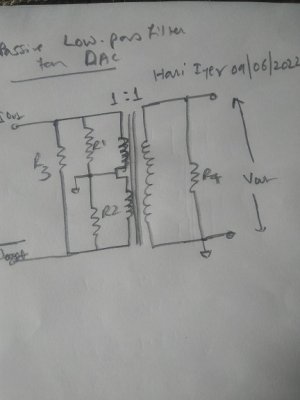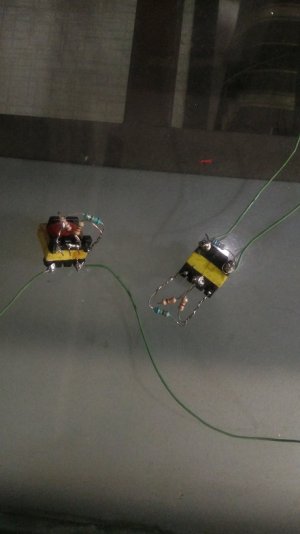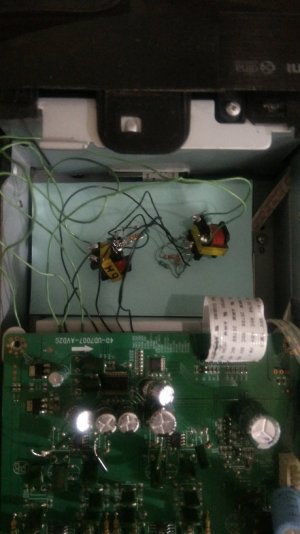This post is in continuation to the below post
 www.hifivision.com
www.hifivision.com
After almost 2 years of tinkering with my Marantz Blueray player DAC board,, i finally am able to conclude on them. I have wasted 2 years of my audio life chasing better opamps, better capacitors and resistors from the stock which the player had. But as there was an inherent design flaw in the active LPF (conceptually), changing better components would have not mattered much. Infact, i have already received my modding componets last week, but something in the back of my mind prevented me from doing this replacement and i avoided.
In continuation of my search, i thought of a passive low pass filter design instead of an active filter and finally came up with a transformer based design. The schematic which i came-up for my DAC chip is as below,

The +ve and -ve Iout from the DAC chip is fed to a blanced transformer and the secondary with the load termination is the output for the DAC. The resistor network for the primary and secondary side needs to be computed based on the DAC chip used and cannot be universal values. We need to check the Iout and the corresponding Vout from the DAC datasheet and compute the load impedance required for the DAC chip. The transformer primary becomes the load for the DAC chip and the resistor network shown in the schematic is required for impedance matching to the required load. For my DAC chip it was 820 ohms. The primary end of the transformer center tap is grounded for a current sink.
If not matched the DAC chip could damage and the I/V conversion would not be 100% accurate. The load resistor in the secondary is required for the required Vp-p. I have computed this value for a Vp-p of around 1v. This is how the final assembly looks.

As this is a prototype - cheap chinese carbon resistors are used for testing. This may later get replaced by a thin film resistor. This is how they look when installed in the Blueray player.

90% of the DAC board is now redundant and i have used only 10% of the board till the DAC chip.
Listening test revaled that they are way superior to active filters and very coherent and accurate. Lows and Highs were excellent from turning them on and mids required 4hr of break-in before they could sound great. The entire FR is now flat. The transformer that i have used is an NEC audio transformer salvaged from a telecom equipment (courtesy my elder brother). What i have realized from this experiment that even the best of op-amps, best of capacitors and resistors which are 100+ in numbers in an active filter can have its own sound signature and color the sound from the original recording. This was the first thing i noticed vis-a-vis active vs passive filter. Even the best R2R DAC will suffer from this problem as there are too many active devices in an R2R DAC giving a chance for coloration. In the passive LPF the SQ is limited by the quality of the audio transformer and the resistors used. I have used a transformer ratio of 1:1. Other ratios like 1:4 or 1:10 will also work equally good.
Any FM who dreams of owning an R2R DAC but did not pursue due to high cost, this is the best economical option and i strongly believe will sound even better than an R2R DAC (imo - as i have never heard an R2R DAC yet). Any one interested to know more can contact me with a PM.
Thanks for looking.
Bypassed Marantz Blueray player UD-7007 HDAM module in the DAC PCB
This mod has a long history as long as 10 years of my listening time. In 2004 i owned a Pioneer DVD DV-373. This was followed by a used Marantz CD player CD-5400 from around 2011 til 2018. I later purchased a Marantz blueray player UD-7007 for its DAC quality and other attributes. I always...
After almost 2 years of tinkering with my Marantz Blueray player DAC board,, i finally am able to conclude on them. I have wasted 2 years of my audio life chasing better opamps, better capacitors and resistors from the stock which the player had. But as there was an inherent design flaw in the active LPF (conceptually), changing better components would have not mattered much. Infact, i have already received my modding componets last week, but something in the back of my mind prevented me from doing this replacement and i avoided.
In continuation of my search, i thought of a passive low pass filter design instead of an active filter and finally came up with a transformer based design. The schematic which i came-up for my DAC chip is as below,

The +ve and -ve Iout from the DAC chip is fed to a blanced transformer and the secondary with the load termination is the output for the DAC. The resistor network for the primary and secondary side needs to be computed based on the DAC chip used and cannot be universal values. We need to check the Iout and the corresponding Vout from the DAC datasheet and compute the load impedance required for the DAC chip. The transformer primary becomes the load for the DAC chip and the resistor network shown in the schematic is required for impedance matching to the required load. For my DAC chip it was 820 ohms. The primary end of the transformer center tap is grounded for a current sink.
If not matched the DAC chip could damage and the I/V conversion would not be 100% accurate. The load resistor in the secondary is required for the required Vp-p. I have computed this value for a Vp-p of around 1v. This is how the final assembly looks.

As this is a prototype - cheap chinese carbon resistors are used for testing. This may later get replaced by a thin film resistor. This is how they look when installed in the Blueray player.

90% of the DAC board is now redundant and i have used only 10% of the board till the DAC chip.
Listening test revaled that they are way superior to active filters and very coherent and accurate. Lows and Highs were excellent from turning them on and mids required 4hr of break-in before they could sound great. The entire FR is now flat. The transformer that i have used is an NEC audio transformer salvaged from a telecom equipment (courtesy my elder brother). What i have realized from this experiment that even the best of op-amps, best of capacitors and resistors which are 100+ in numbers in an active filter can have its own sound signature and color the sound from the original recording. This was the first thing i noticed vis-a-vis active vs passive filter. Even the best R2R DAC will suffer from this problem as there are too many active devices in an R2R DAC giving a chance for coloration. In the passive LPF the SQ is limited by the quality of the audio transformer and the resistors used. I have used a transformer ratio of 1:1. Other ratios like 1:4 or 1:10 will also work equally good.
Any FM who dreams of owning an R2R DAC but did not pursue due to high cost, this is the best economical option and i strongly believe will sound even better than an R2R DAC (imo - as i have never heard an R2R DAC yet). Any one interested to know more can contact me with a PM.
Thanks for looking.

